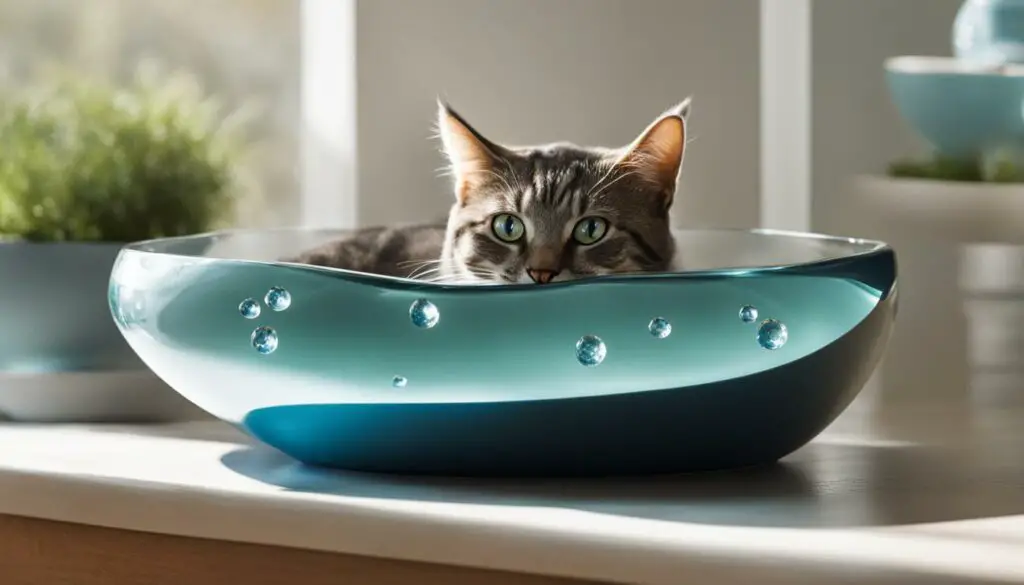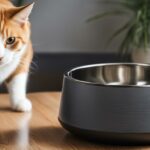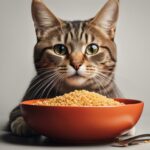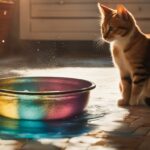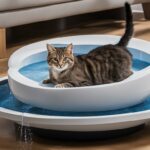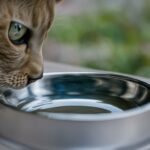Cats need fresh and clean water for their overall health. Choosing the right water bowl for your cat is crucial to ensure they stay hydrated. In this article, I will explore the benefits of using a weighted water bowl for cats and provide a guide to help you choose the perfect one for your feline friend.
Key Takeaways:
- Weighted water bowls provide stability and prevent tipping or spilling.
- They can help cats with whisker fatigue by providing a wide and shallow design.
- Consider factors such as material, size, and design when choosing a weighted water bowl.
- Regular cleaning and maintenance are essential to promote optimal hygiene.
- Consult with a veterinarian for personalized recommendations and guidance regarding your cat’s hydration needs.
The Importance of Hydration for Cats
Proper hydration is essential for the well-being of cats. Cats need to drink a sufficient amount of water to support the functioning of their urinary tract, kidneys, and other organs. However, cats often have a low thirst drive and can be picky about their drinking vessels. Providing a weighted water bowl can encourage them to drink more water and maintain optimal hydration.
Cat hydration plays a vital role in their overall health. Water helps regulate body temperature, aids digestion, and supports the transportation of nutrients and oxygen throughout their bodies. Adequate hydration also promotes healthy skin and coat, helps prevent urinary tract infections, and ensures proper kidney function. Cats that do not drink enough water are at risk of dehydration, which can lead to various health issues and discomfort.
Weighted water bowls are designed to provide stability, preventing tipping or spilling. The added weight keeps the bowl in place, ensuring that cats can access water whenever they need it. This is particularly beneficial for cats who are prone to playing with their water or have a tendency to knock over their bowls. By using a weighted water bowl, cat owners can promote consistent water intake and minimize the risk of dehydration.
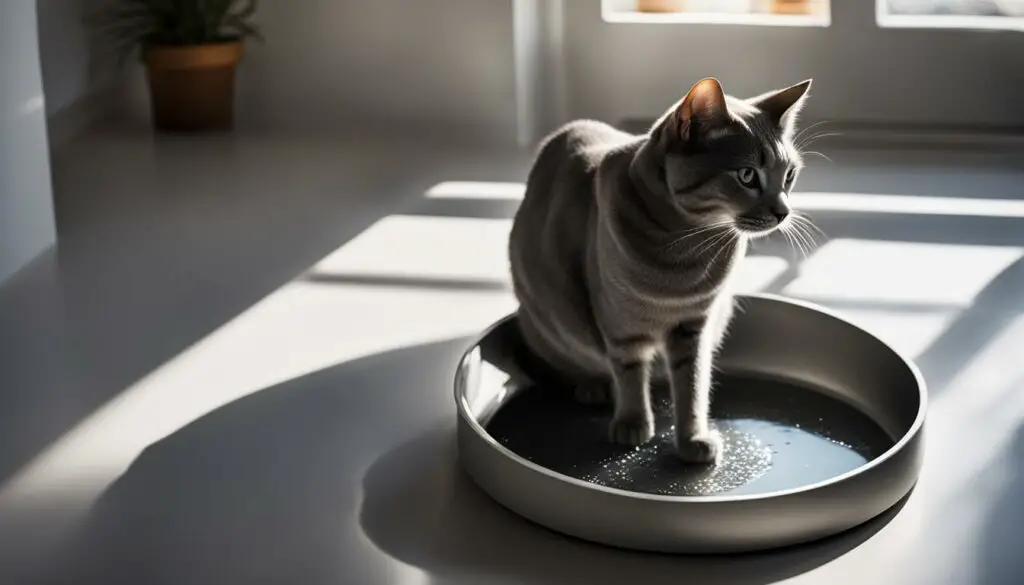
In addition to stability, weighted water bowls can also help cats with whisker fatigue. Whisker fatigue occurs when a cat’s sensitive whiskers brush against the sides of a narrow bowl, causing discomfort and stress. Weighted bowls typically have a wider and shallower design that doesn’t touch the cat’s whiskers, providing a more comfortable drinking experience. This can encourage cats to drink more water and maintain proper hydration levels.
Types of Water Bowls for Cats
Cats have different preferences when it comes to their water bowls. There are several types of water bowls available in the market, each with its own advantages and disadvantages. Some common types include plastic, ceramic, and stainless steel.
Plastic cat water bowls are lightweight and affordable, making them a popular choice. However, they may not be as durable as other options and can develop scratches or cracks over time. Additionally, plastic bowls can sometimes contain harmful chemicals that may leach into the water, posing potential health risks for your cat.
Ceramic cat water bowls are non-toxic and can be decorated to match your home decor. They are generally more heavy and breakable than plastic bowls, but they are also less likely to develop scratches or cracks. Ceramic bowls can provide a stable drinking experience for your cat.
Stainless steel cat water bowls are recommended for their durability and hygiene. They are scratch-resistant and easy to clean, making them a popular choice among cat owners. Stainless steel bowls are also less likely to retain odors or stains, ensuring that your cat’s water remains fresh and clean.
| Type of Water Bowl | Advantages | Disadvantages |
|---|---|---|
| Plastic | Lightweight and affordable | Potential durability issues and health risks |
| Ceramic | Non-toxic and can be decorated to match home decor | Heavy and breakable |
| Stainless Steel | Durable, scratch-resistant, and hygienic | N/A |
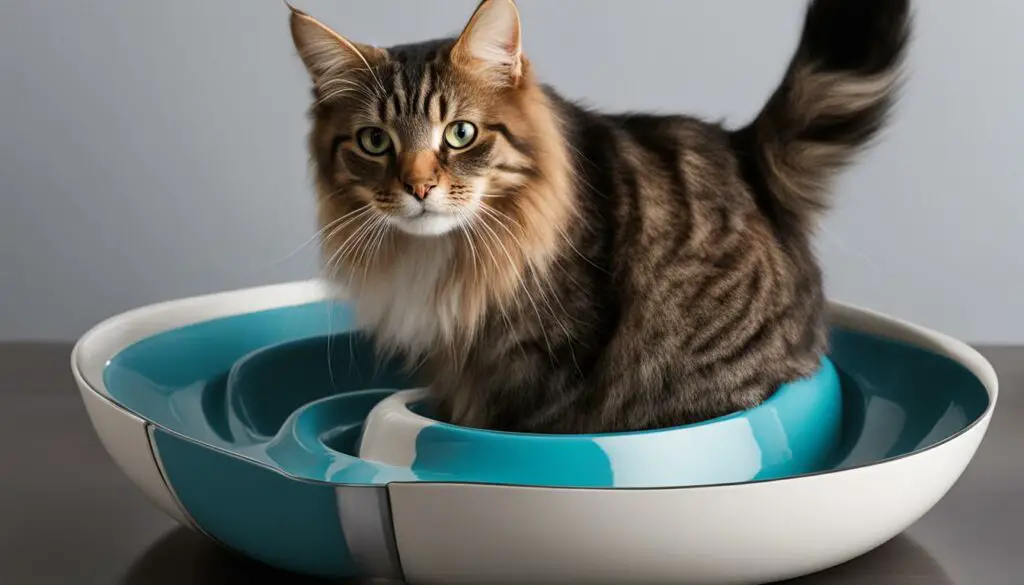
When choosing a water bowl for your cat, consider their preferences and your own needs. Each type of water bowl offers different benefits, and it’s important to select one that is suitable for your cat’s hydration requirements and your lifestyle.
Additionally, it’s important to regularly clean and maintain your cat’s water bowl to ensure optimal hygiene. Regardless of the type of water bowl you choose, make sure to wash it regularly with soap and water or use a dishwasher-safe option. Providing your cat with a clean and fresh source of water will help promote their overall health and well-being.
Benefits of a Weighted Water Bowl
A weighted water bowl offers several benefits for cats. One of the main advantages is its non-tip and stable design, which prevents tipping and spilling. This ensures that your cat always has access to water, even if they accidentally bump into the bowl or playfully paw at it. The stability provided by a weighted water bowl is particularly beneficial for cats who tend to be active or have a mischievous nature.
In addition to preventing spills, a weighted water bowl can also help cats with whisker fatigue. Whisker fatigue occurs when a cat’s sensitive whiskers constantly touch the sides of a narrow or deep bowl while drinking. This can be uncomfortable for cats and may discourage them from drinking enough water. Weighted water bowls often feature a wide and shallow design that allows cats to drink without their whiskers coming into contact with the edges of the bowl, promoting a more comfortable drinking experience.
“Weighted water bowls offer stability and prevent spills, ensuring that your cat always has access to water.”
Furthermore, gravity water bowls, which are a type of weighted water bowl, provide a consistent flow of water. The water is automatically replenished as your cat drinks, ensuring that the water remains fresh and inviting throughout the day. This can be especially beneficial for cats who prefer running water or have a higher water intake.
| Benefits of a Weighted Water Bowl | Advantages of Gravity Water Bowls | Non-Tip Water Bowls for Cats | Stability in Cat Water Bowls |
|---|---|---|---|
| Prevents tipping and spilling | Provides a consistent flow of water | Reduces the risk of accidents and messes | Ensures easy access to water for cats |
| Helps prevent whisker fatigue | Keeps water fresh and inviting | Promotes a more comfortable drinking experience | Suitable for active or mischievous cats |
In summary, a weighted water bowl offers stability, prevents spills, and can help alleviate whisker fatigue in cats. Gravity water bowls, in particular, provide a consistent flow of fresh water. Choosing a weighted water bowl for your cat can ensure that they have easy access to water and support their overall hydration and well-being.
Factors to Consider When Choosing a Weighted Water Bowl
When selecting a weighted water bowl for your cat, there are several important factors to consider. These factors will help you choose a bowl that meets your cat’s needs and ensures their optimal hydration. Here are the key factors to keep in mind:
- Size of Cat Water Bowl: The size of the water bowl should be appropriate for your cat’s breed and weight. A larger cat may require a bigger bowl to hold an adequate amount of water, while smaller cats may prefer a shallower bowl to prevent whisker discomfort.
- Design of Cat Water Bowl: Consider the design features that will benefit both you and your cat. Look for a non-slip base to prevent accidents, and an anti-splash rim to keep water contained. Additionally, choose a bowl that is easy to clean and maintain.
- Durability of Cat Water Bowl: Ensure that the water bowl is durable and resistant to scratches, cracks, and breakage. Stainless steel bowls are known for their durability, while ceramic and plastic bowls may have varying levels of durability.
By considering these factors, you can choose a weighted water bowl that provides stability, comfort, and convenience for both you and your cat.
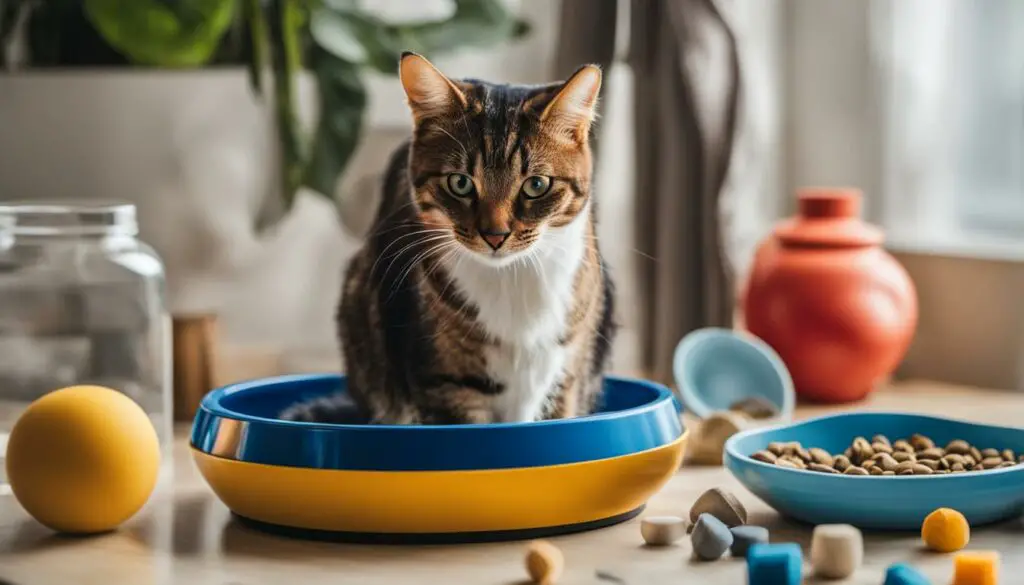
Recommended Weighted Water Bowls for Cats
Choosing the right weighted water bowl for your cat is essential for their hydration and overall well-being. Here are some top-rated options that cat owners highly recommend:
1. PEGGY11 Stainless Steel Cat Bowls
This stainless steel cat bowl is known for its durability and ergonomic design. The weighted base ensures stability, preventing tipping or spilling. It is also scratch-resistant and easy to clean, making it a convenient choice for cat owners. The wide and shallow design of the bowl prevents whisker discomfort, making it suitable for cats with sensitive whiskers.
2. Y YHY Elevated Water Bowl for Cats
This elevated water bowl combines functionality with modern design. The anti-slip base keeps the bowl in place, even during playful moments. The elevated height promotes a more comfortable drinking position for cats, reducing strain on their neck and joints. The ceramic material is non-toxic and can be easily cleaned. The bowl is also dishwasher safe, allowing for hassle-free maintenance.
3. LIONWEI LIONWELI Ceramic Elevated Water Bowl for Cats
This ceramic water bowl offers a stylish and modern design that complements any home decor. The elevated height provides a comfortable drinking position for cats, reducing the risk of neck strain. The ceramic material is non-toxic and keeps the water cool for longer periods. The bowl is also dishwasher safe, ensuring easy cleaning and maintenance.
4. Van Ness Stainless Steel Cat Bowl
This stainless steel cat bowl is designed with a non-slip rubber base to prevent tipping or sliding. The wide and shallow design accommodates cats’ sensitive whiskers, ensuring a comfortable drinking experience. The stainless steel material is durable and resistant to scratches, making it a long-lasting option. The bowl is also dishwasher safe, allowing for effortless cleaning.
5. Serentive Non-Slip Stainless Steel Cat Bowls
These stainless steel cat bowls are ideal for small cats. The non-slip base keeps the bowl in place, minimizing spills and mess. The shallow design prevents whisker discomfort, making it suitable for cats with sensitive whiskers. The stainless steel material is durable and easy to clean, ensuring long-lasting use. The bowls are also dishwasher safe, providing convenience for busy cat owners.
| Weighted Water Bowl | Material | Design | Durability | Hygienic |
|---|---|---|---|---|
| PEGGY11 Stainless Steel Cat Bowls | Stainless steel | Ergonomic | Durable | Easy to clean |
| Y YHY Elevated Water Bowl for Cats | Ceramic | Elevated | Durable | Dishwasher safe |
| LIONWEI LIONWELI Ceramic Elevated Water Bowl for Cats | Ceramic | Elevated | Durable | Dishwasher safe |
| Van Ness Stainless Steel Cat Bowl | Stainless steel | Non-slip base | Durable | Dishwasher safe |
| Serentive Non-Slip Stainless Steel Cat Bowls | Stainless steel | Non-slip base | Durable | Dishwasher safe |
Material Options for Weighted Water Bowls
When looking for a weighted water bowl for your cat, it’s important to consider the material options available. Different materials offer various benefits and considerations, so choosing the right one for your cat’s needs is essential.
One popular material for weighted water bowls is stainless steel. Stainless steel bowls are known for their durability and scratch resistance. They are also easy to clean and maintain, making them a hygienic choice for your cat’s water source. Additionally, stainless steel bowls are often resistant to bacteria buildup, ensuring that your cat’s water stays fresh and clean.
Another material option for weighted water bowls is ceramic. Ceramic bowls are non-toxic and can be decorated to match your home decor. They are generally heavier, providing stability and preventing tipping. However, ceramic bowls can be more prone to breakage if dropped or mishandled, so it’s important to consider the durability factor when choosing a ceramic bowl.
Plastic bowls are also available as weighted water bowls. They are lightweight and affordable, making them a popular choice for many cat owners. However, plastic bowls may not be as durable as stainless steel or ceramic options, and they can potentially contain harmful chemicals if not made from high-quality, BPA-free materials. It’s important to choose a plastic bowl that is specifically designed for pet use and meets safety standards.
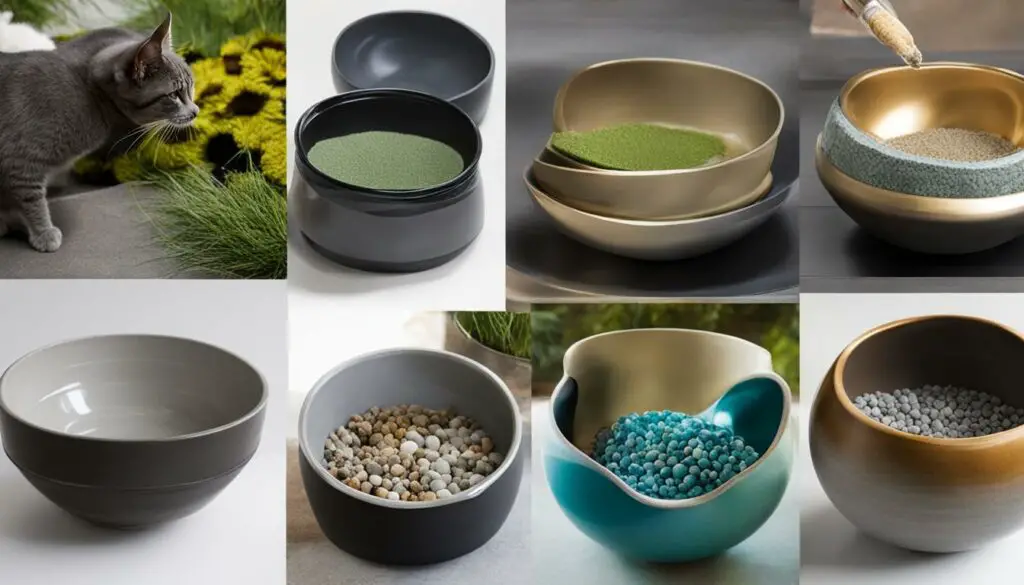
Material Comparison Table:
| Material | Advantages | Disadvantages |
|---|---|---|
| Stainless Steel | Durable, scratch-resistant, easy to clean | Can be more expensive, may not match all home decors |
| Ceramic | Non-toxic, customizable, offers stability | Breakable if mishandled, heavier |
| Plastic | Lightweight, affordable | Less durable, potential for harmful chemicals |
Size Considerations for Weighted Water Bowls
Choosing the right size of a weighted water bowl for your cat is crucial for their comfort and hydration needs. Cats come in different sizes, so it’s important to consider their breed and weight when selecting a water bowl. A bowl that is too small may not hold enough water for the day, while a bowl that is too large may be difficult for smaller cats to access.
For kittens or smaller breeds, a shallow and compact bowl is recommended. This allows them to comfortably reach the water without straining their necks or whiskers. On the other hand, larger cats may require a deeper and wider bowl to accommodate their size and drinking habits. Remember to choose a bowl that provides enough water for your cat’s daily hydration needs, promoting a healthy and consistent water intake.
Comparison of Weighted Water Bowl Sizes
| Breed Size | Ideal Weighted Water Bowl Size |
|---|---|
| Kittens and Small Breeds | 6-8 ounces |
| Medium-sized Breeds | 12-16 ounces |
| Large Breeds | 16-24 ounces |
Choosing the right size of a weighted water bowl is crucial for your cat’s well-being. It ensures they have access to an adequate water supply, promoting proper hydration and preventing dehydration-related health issues. Observing your cat’s drinking habits and monitoring their water consumption can also help determine if a larger or smaller size bowl is needed.
By considering your cat’s size and providing the appropriate weighted water bowl, you can ensure they stay hydrated and healthy. Remember to clean the bowl regularly and refill it with fresh water daily to maintain optimal hygiene. Your cat’s well-being depends on their access to a suitable and properly sized water bowl.
Design Features of Non-Tip Water Bowls
When choosing a weighted water bowl for your cat, it’s important to consider the design features that enhance its functionality and convenience. Here are some key design aspects to look for:
- Non-Slip Base: A non-slip base prevents the water bowl from sliding or tipping over, ensuring stability and reducing the risk of spills or accidents.
- Anti-Splash Rim: An anti-splash rim helps to minimize water splashing out of the bowl, keeping the surrounding area clean and dry.
- Wide and Shallow Design: Cats can be sensitive to having their whiskers touch the sides of the bowl. A wide and shallow design allows for comfortable drinking without whisker discomfort.
- Easy-to-Grip Surface: A water bowl with an easy-to-grip surface makes it convenient for both you and your cat to handle and carry the bowl, especially during refills or cleaning.
By considering these design features, you can find a non-tip water bowl that is practical, functional, and suitable for your cat’s needs.
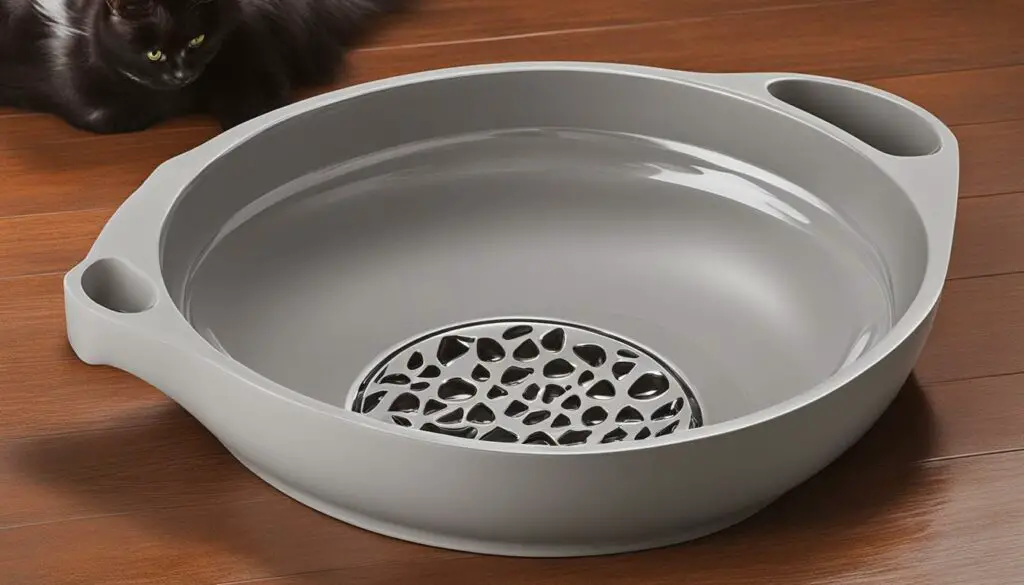
Quotes:
I love how the non-slip base of this water bowl keeps it in place, even when my cat gets a little playful with it. No more spills or mess to clean up!
The wide and shallow design of this water bowl is perfect for my cat. She no longer avoids drinking water because of whisker discomfort.
Table: Comparison of Non-Tip Water Bowls
| Water Bowl | Non-Slip Base | Anti-Splash Rim | Wide and Shallow Design | Easy-to-Grip Surface |
|---|---|---|---|---|
| PremiumCat Water Bowl | Yes | Yes | Yes | Yes |
| SafePaws Water Bowl | Yes | Yes | No | Yes |
| CozyKitty Water Bowl | Yes | No | Yes | No |
Table: Comparison of non-tip water bowls showcasing key design features
When choosing a non-tip water bowl for your cat, consider the design features that will best suit your cat’s preferences and needs. Whether it’s a non-slip base, an anti-splash rim, a wide and shallow design, or an easy-to-grip surface, each feature contributes to a more convenient and enjoyable drinking experience for your feline friend.
Durability and Safety of Weighted Water Bowls
When it comes to choosing a weighted water bowl for your cat, durability and safety are two crucial factors to consider. You want a bowl that will withstand your cat’s playful nature and daily use without easily breaking or getting damaged. Additionally, ensuring that the bowl is safe for your cat to use is essential for their well-being.
Table: Comparison of Durability and Safety of Different Materials
| Material | Durability | Safety |
|---|---|---|
| Stainless Steel | Durable and scratch-resistant | Safe, as long as it is BPA-free and does not contain harmful chemicals |
| Ceramic | Fragile and prone to breakage | Safe, as long as it is lead-free and doesn’t have any toxic glazes |
| Plastic | Less durable and can scratch easily | Potentially unsafe, as some plastics may contain harmful chemicals like BPA |
Stainless steel bowls are known for their durability and scratch resistance. They can withstand rough handling and are less prone to breakage compared to ceramic bowls. However, it is crucial to choose a stainless steel bowl that is BPA-free and doesn’t contain any harmful chemicals. Ceramic bowls, while aesthetically pleasing, can be fragile and more prone to breakage, so extra care should be taken to prevent accidents. Ensure that the ceramic bowl is lead-free and doesn’t have any toxic glazes.
Plastic bowls are lightweight and affordable, but they may not be as durable as stainless steel or ceramic. They can easily scratch, which makes them more prone to harboring bacteria over time. It’s important to choose a plastic bowl that is BPA-free and doesn’t contain any harmful chemicals that could leach into the water and potentially endanger your cat’s health.
“When it comes to durability and safety, stainless steel is the top choice for a weighted water bowl for cats. It provides long-lasting use and is easy to clean, making it a hygienic option. However, if you prefer a more decorative bowl, ceramic can be a good choice as long as it is lead-free and doesn’t have any toxic glazes. Plastic bowls should be used with caution due to their potential for scratching and containing harmful chemicals.”
Home Compatibility and Multiple Cats
When considering a weighted water bowl for your cat, it’s important to take into account the compatibility of the bowl with your home environment. You want to ensure that the bowl fits in the available space and blends well with your decor. Consider the size, shape, and design of the bowl in relation to the area where you plan to place it. Additionally, think about the stability of the bowl and whether it has a non-slip base to prevent accidental spills or tipping.
If you have multiple cats in your household, it’s recommended to have more than one water bowl. This helps to prevent competition and stress between cats, ensuring that each cat has their own accessible water source. Cats can be territorial, and having multiple water bowls reduces the likelihood of conflicts and promotes a peaceful coexistence. Place the water bowls in different areas of your home, making sure to provide easy access for each cat.
By considering the home compatibility of the water bowl and accommodating multiple cats with separate bowls, you can create a harmonious environment that encourages hydration for all your feline friends.
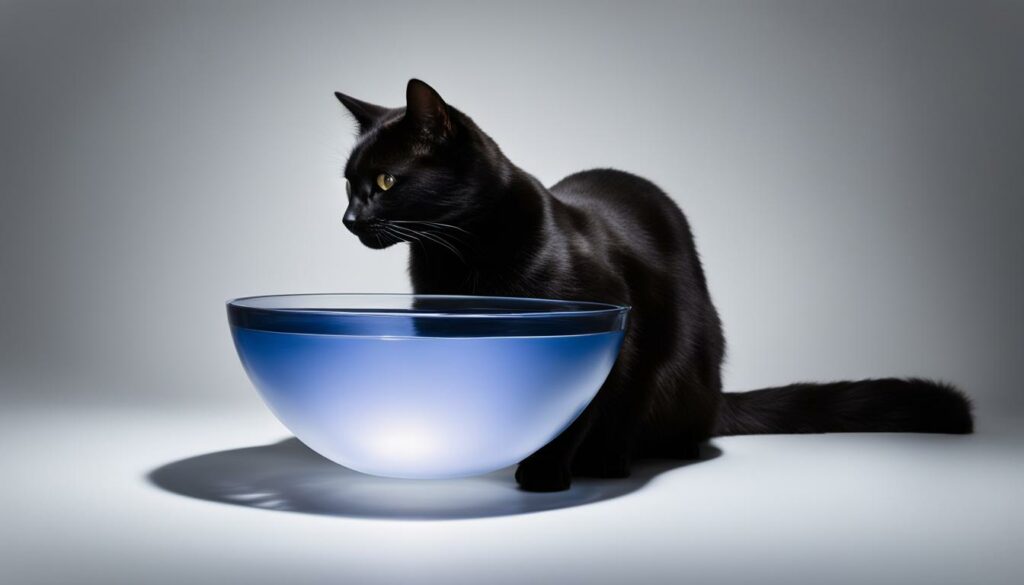
Table: Comparison of Cat Water Bowls for Multiple Cats
| Water Bowl | Features | Price | Rating |
|---|---|---|---|
| Catit Flower Fountain | Multiple drinking areas, quiet operation, water flow control | $34.99 | 4.5/5 |
| PetSafe Drinkwell Stainless Steel Multi-Pet Fountain | Large capacity, adjustable water flow, stainless steel construction | $69.95 | 4.7/5 |
| Hagen Dogit Design Fresh & Clear Drinking Fountain | 360-degree drinking surface, carbon filter, quiet operation | $49.99 | 4.3/5 |
| Pioneer Pet Big Max Stainless Steel Fountain | Large capacity, replaceable charcoal filter, dishwasher safe | $49.99 | 4.6/5 |
Table: Comparison of cat water bowls for multiple cats, including their features, prices, and ratings.
Cat Preference for Weighted Water Bowls
Cats are known for their unique preferences, and this extends to their choice of water bowls. While some cats may not have specific preferences, others may show a clear preference for certain types of water bowls. As a cat owner, it’s important to cater to your cat’s preferences to ensure their comfort and satisfaction.
One common preference among cats is the shape and size of the water bowl. Some cats may prefer wider bowls that don’t touch their sensitive whiskers, while others may prefer deeper bowls that allow them to immerse their entire face while drinking. By observing your cat’s behavior, you can determine the ideal shape and size that they prefer.
The material of the water bowl is another factor that can influence a cat’s preference. Some cats may prefer the cool touch of ceramic or stainless steel bowls, while others may be more comfortable with the lightweight and familiar feel of a plastic bowl. Experimenting with different materials can help you find the one that your cat prefers.
Lastly, some cats may have color or texture preferences when it comes to their water bowls. They may be more attracted to bowls with bright colors or interesting patterns. Additionally, some cats may prefer bowls with a textured surface that provides better grip while drinking.
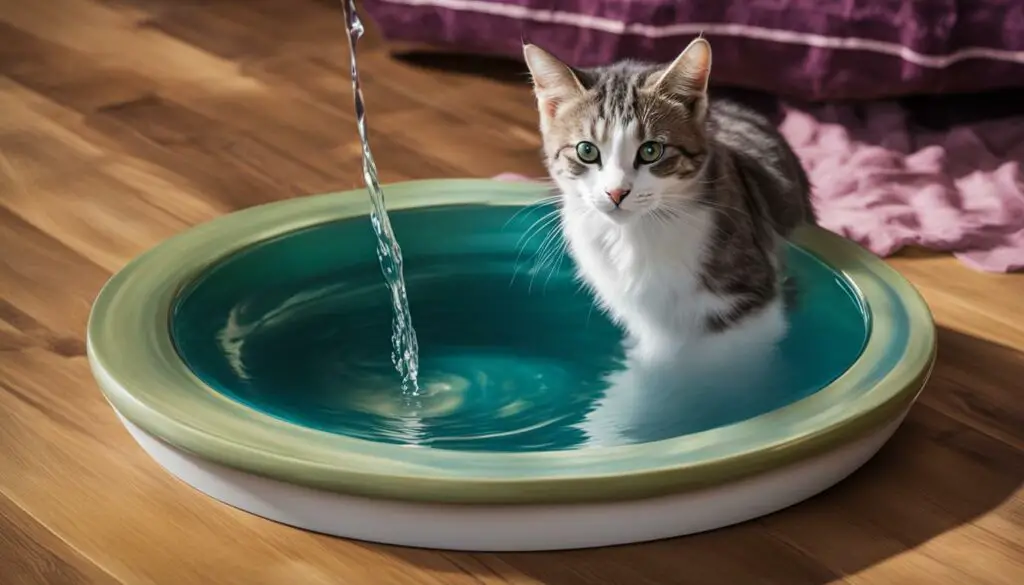
Remember, every cat is unique, and their preferences may vary. By paying attention to your cat’s behavior and preferences, you can choose a weighted water bowl that they will enjoy using. Providing them with a water bowl that meets their preferences can encourage them to drink more water and stay hydrated.
Cleaning and Maintenance of Weighted Water Bowls
Proper cleaning and maintenance of weighted water bowls are essential for the health and well-being of your cat. Regular cleaning helps prevent bacterial growth and ensures a clean source of water for your feline friend. Most weighted water bowls can be easily cleaned with soap and water or placed in the dishwasher for convenience. It’s important to avoid using harsh chemicals or abrasive cleaners that could damage the bowl or leave harmful residues.
To clean a weighted water bowl, start by emptying any remaining water and removing any food particles or debris. Wash the bowl thoroughly with soap and warm water, using a sponge or brush to scrub away any stains or residue. Rinse the bowl thoroughly to ensure no soap is left behind. If the bowl is dishwasher safe, you can also place it on the top rack of your dishwasher for a more thorough cleaning.
In addition to regular cleaning, it’s important to regularly check and maintain your cat’s weighted water bowl. Inspect the bowl for any signs of wear or damage, such as cracks or breakage. Replace the bowl if any defects are found to ensure your cat’s safety. Additionally, check the non-slip base or anti-splash rim if your bowl has one, and ensure they are securely attached and functioning properly. This helps prevent spills and accidents while your cat is drinking.
Lastly, consider the cleaning frequency for your cat’s water bowl. While weekly cleaning is generally sufficient, you may need to clean the bowl more frequently if your cat is prone to knocking over the bowl or if you notice any odor or slime buildup. Regularly refreshing the water in the bowl is also important to ensure it stays clean and appealing to your cat. Pay attention to any changes in your cat’s water consumption or behavior, as this may indicate a need for more frequent cleaning or a different type of water bowl.
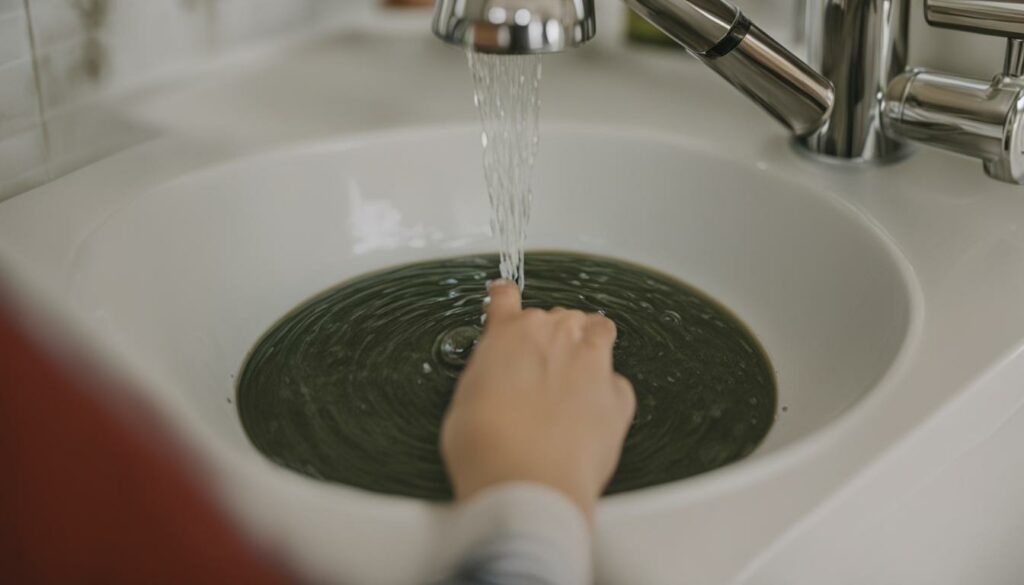
Tips for Cleaning and Maintaining Weighted Water Bowls:
- Empty and clean the bowl regularly with soap and warm water.
- Check for any wear or damage, such as cracks or breakage.
- Inspect the non-slip base or anti-splash rim for secure attachment.
- Frequently refresh the water and monitor your cat’s water consumption.
Table: Cleaning Frequency for Cat Water Bowls
| Type of Bowl | Cleaning Frequency |
|---|---|
| Stainless Steel | Once a week |
| Ceramic | Once a week |
| Plastic | Twice a week |
“Regular cleaning and maintenance of your cat’s weighted water bowl ensure a clean and hygienic water source, promoting your cat’s health and well-being.”
Conclusion
In conclusion, choosing the right weighted water bowl for your cat is crucial for their hydration and overall health. A weighted water bowl provides stability, preventing spills and ensuring easy access to water for your feline friend. Cats may have preferences for certain materials, shapes, and sizes of water bowls, so it’s important to observe their behavior and adjust the bowl accordingly. Factors such as material, size, design, durability, and your cat’s preferences should all be considered when making your decision. Regular cleaning and maintenance of the water bowl are essential to promote optimal hygiene and prevent bacteria buildup.
Remember the importance of cat hydration and the role a weighted water bowl can play in encouraging your cat to drink more water. Proper hydration supports the functioning of their urinary tract, kidneys, and other organs. It’s crucial to choose a water bowl that suits your cat’s needs and preferences to ensure they stay hydrated and healthy.
When selecting a weighted water bowl, consider factors such as the material’s durability and safety, the bowl’s size and design features, as well as the compatibility with your home. Stainless steel bowls are often recommended for their durability and hygienic properties. Ceramic bowls can be stylish but may be heavier and more breakable. Plastic bowls are lightweight but may not be as durable. Additionally, pay attention to your cat’s preferences for the bowl’s shape, size, and even texture.
| Table 1: Recommended Weighted Water Bowls for Cats |
|---|
| PEGGY11 Stainless Steel Cat Bowls |
| Y YHY Elevated Water Bowl for Cats |
| LIONWEI LIONWELI Ceramic Elevated Water Bowl for Cats |
| Van Ness Stainless Steel Cat Bowl |
| Serentive Non-Slip Stainless Steel Cat Bowls |
These recommended weighted water bowls have received positive reviews and are known for their durability, ergonomic designs, and slip-resistant properties. However, it’s important to consider your cat’s specific needs and preferences before making a final decision.
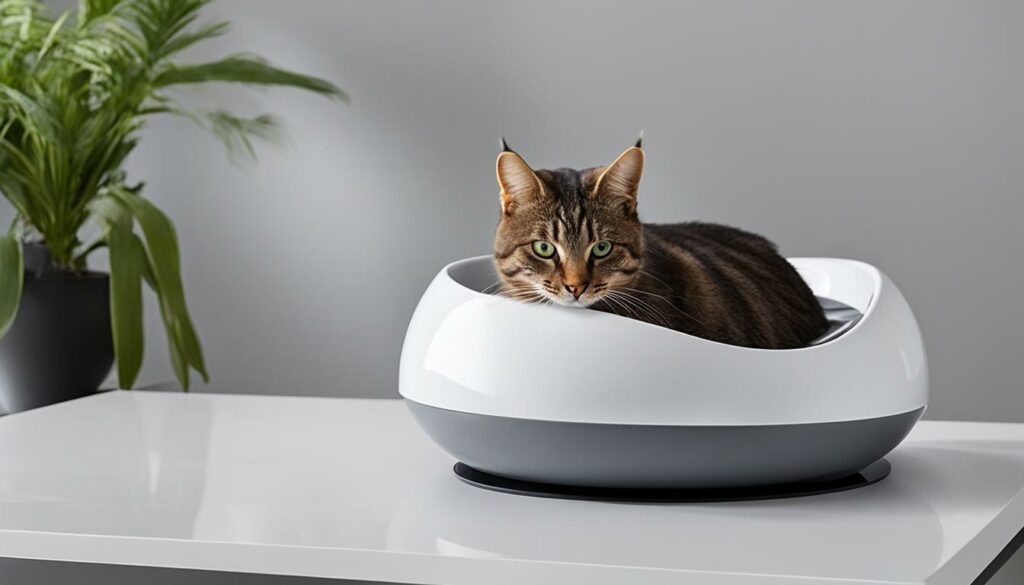
Additional Resources
- [First Source]: Provides comprehensive information on various water bowl options for cats, including reviews and recommendations.
- [Second Source]: Offers a detailed guide on choosing the best water bowl for your cat, including the top picks in different categories.
- [Third Source]: Provides insights and recommendations on the best cat water bowls, including their features and benefits.
Remember that choosing the right weighted water bowl is just one aspect of ensuring your cat stays hydrated. It’s also important to provide fresh and clean water daily and pay attention to any changes in your cat’s drinking habits. If you have any concerns about your cat’s hydration or overall health, consult with a qualified veterinarian for personalized recommendations and guidance.
Additional Resources
For more information on cat hydration and care, here are some valuable resources to explore:
Cat Hydration Resources
- Cat Hydration 101: Keeping Your Feline Friend Well-Hydrated” – A comprehensive guide on cat hydration, including tips on encouraging your cat to drink more water and signs of dehydration. [Link to the first source]
- “The Importance of Water for Cats: A Deep Dive into Feline Hydration” – An in-depth article that explores the physiology of cat hydration and its impact on their overall health. [Link to the second source]
Cat Water Bowl Tips
- Choosing the Perfect Water Bowl for Your Cat: A Buyer’s Guide” – A detailed resource that provides insights on selecting the right water bowl for your cat’s needs, including factors to consider and tips for cleaning and maintenance. [Link to the third source]
- Water Bowl Alternatives for Cats: Exploring Different Options” – An article that highlights alternative methods to provide water to cats, such as pet fountains and DIY hydration stations. [Link to the fourth source]
Cat Care Resources
- Essential Cat Care Tips: Keeping Your Feline Friend Happy and Healthy” – A comprehensive guide that covers various aspects of cat care, including nutrition, grooming, and exercise. [Link to the fifth source]
- “Understanding Your Cat’s Behavior: Insights into Their Unique Personalities” – An informative resource that delves into the behavior of cats and offers tips on how to better understand and communicate with them. [Link to the sixth source]
Take advantage of these resources to enhance your knowledge and provide the best care for your beloved feline companion.
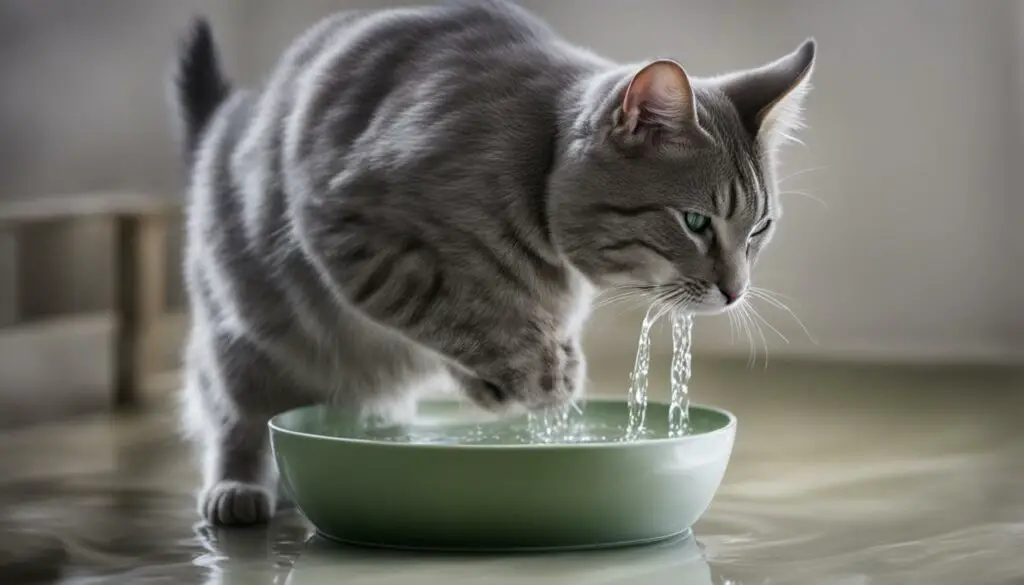
Disclaimer
I understand that choosing the right weighted water bowl for your furry friend is important to you. However, it’s essential to note that the information provided in this article is for educational purposes only. While I strive to provide accurate and up-to-date information, I am not a veterinarian. Therefore, I highly recommend consulting with a qualified veterinarian for personalized recommendations and guidance regarding your cat’s health and hydration needs.
Please keep in mind that every cat is unique, and their specific requirements may vary. Factors such as age, breed, health conditions, and individual preferences can all influence the choice of a weighted water bowl. Your veterinarian will be best equipped to evaluate your cat’s specific needs and provide tailored advice.
Additionally, the availability and suitability of certain water bowl options may vary based on your location or specific circumstances. Therefore, it’s crucial to consider all relevant factors and gather additional information from reputable sources before making any final decisions or purchases.
The well-being of your cat is of utmost importance, and I encourage you to prioritize their health and happiness above all else. By working closely with your veterinarian and taking your cat’s individual needs into account, you can make an informed decision regarding the best weighted water bowl for your beloved feline companion.
FAQ
What are the benefits of using a weighted water bowl for cats?
A weighted water bowl provides stability and prevents tipping or spilling, ensuring that your cat always has access to water. It can also help cats with whisker fatigue by providing a wide and shallow design that doesn’t touch their sensitive whiskers.
What factors should I consider when choosing a weighted water bowl for my cat?
Important factors to consider include the size of the bowl, its design features such as a non-slip base and anti-splash rim, and its durability. It should be appropriately sized for your cat’s breed and weight, convenient for both you and your cat to use, and resistant to scratches, cracks, and breakage.
What are some recommended weighted water bowls for cats?
Some highly recommended options include PEGGY11 Stainless Steel Cat Bowls, Y YHY Elevated Water Bowl for Cats, LIONWEI LIONWELI Ceramic Elevated Water Bowl for Cats, Van Ness Stainless Steel Cat Bowl, and Serentive Non-Slip Stainless Steel Cat Bowls.
What materials are available for weighted water bowls?
You can find weighted water bowls made of stainless steel, ceramic, and plastic. Stainless steel bowls are durable and easy to clean, while ceramic bowls are non-toxic and can be decorated. Plastic bowls are lightweight and affordable, but may not be as durable or safe.
How do I choose the right size for a weighted water bowl?
The size of the bowl should be appropriate for your cat’s breed and weight, ensuring they have enough water for the day. Smaller bowls are suitable for kittens or small breeds, while larger bowls are needed for bigger cats.
What design features should I look for in a weighted water bowl?
Look for a non-slip base and an anti-splash rim to prevent spills and accidents. The bowl should also be easy to clean and disinfect, with no crevices or corners that can trap bacteria.
Are weighted water bowls durable and safe?
Stainless steel bowls are known for their durability, while ceramic and plastic bowls may vary in durability. It’s important to choose bowls made from safe materials that don’t contain harmful chemicals. Hygiene is also crucial, with dishwasher-safe or easily cleanable bowls that don’t retain odors or stains.
Can I use a weighted water bowl if I have multiple cats?
It’s recommended to provide each cat with their own water source to prevent competition and stress. Consider getting more than one water bowl if you have multiple cats.
How often should I clean a weighted water bowl?
Most bowls should be cleaned at least once a week with soap and water or in a dishwasher. Avoid using harsh chemicals or abrasive cleaners that could damage the bowl or leave harmful residue.
Where can I find more resources on cat hydration and care?
For more information, you can explore the following resources:
– [First Source]
– [Second Source]
– [Third Source]
Is the information provided in this article a substitute for professional veterinary advice?
No, always consult with a qualified veterinarian for personalized recommendations and guidance regarding your cat’s health and hydration needs.
Source Links
- https://cats.com/best-cat-water-bowls
- https://www.fresnobee.com/reviews/best-water-bowl-for-cats/
- https://www.thesprucepets.com/best-cat-water-bowls-4682626

